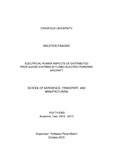JavaScript is disabled for your browser. Some features of this site may not work without it.
| dc.contributor.advisor | Malkin, Peter | |
| dc.contributor.author | Pagonis, Meletios | |
| dc.date.accessioned | 2016-05-11T09:43:45Z | |
| dc.date.available | 2016-05-11T09:43:45Z | |
| dc.date.issued | 2015-10 | |
| dc.identifier.uri | http://dspace.lib.cranfield.ac.uk/handle/1826/9873 | |
| dc.description.abstract | The aerospace industry is currently looking at options for fulfilling the technological development targets set for the next aircraft generations. Conventional engines and aircraft architectures are now at a maturity level which makes the realisation of these targets extremely problematic. Radical solutions seem to be necessary and Electric Distributed Propulsion is the most promising concept for future aviation. Several studies showed that the viability of this novel concept depends on the implementation of a superconducting power network. The particularities of a superconducting power network are described in this study where novel components and new design conditions of these networks are highlighted. Simulink models to estimate the weight of fully superconducting machines have been developed in this research work producing a relatively conservative prediction model compared to the NASA figures which are the only reference available in the literature. A conceptual aircraft design architecture implementing a superconducting secondary electrical power system is also proposed. Depending on the size of the aircraft, and hence the electric load demand, the proposed superconducting architecture proved to be up to three times lighter than the current more electric configurations. The selection of such a configuration will also align with the general tendency towards a superconducting network for the proposed electric distributed propulsion concept. In addition, the hybrid nature of these configurations has also been explored and the potential enhanced role of energy storage mechanisms has been further investigated leading to almost weight neutral but far more flexible aircraft solutions. For the forecast timeframe battery technology seems the only viable choice in terms of energy storage options. The anticipated weight of the Lithium sulphur technology is the most promising for the proposed architectures and for the timeframe under investigation. The whole study is based on products and technologies which are expected to be available on the 2035 timeframe. However, future radical changes in energy storage technologies may be possible but the approach used in this study can be readily adapted to meet such changes. | en_UK |
| dc.language.iso | en | en_UK |
| dc.publisher | Cranfield University | en_UK |
| dc.rights | © Cranfield University, 2015. All rights reserved. No part of this publication may be reproduced without the written permission of the copyright holder. | en_UK |
| dc.subject | Superconductivity | en_UK |
| dc.subject | Electric | en_UK |
| dc.subject | Power | en_UK |
| dc.subject | Networks | en_UK |
| dc.subject | Machines | en_UK |
| dc.subject | Energy | en_UK |
| dc.subject | Storage | en_UK |
| dc.subject | More | en_UK |
| dc.subject | Aircraft | en_UK |
| dc.subject | Battery | en_UK |
| dc.title | Electrical power aspects of distributed propulsion systems in turbo-electric powered aircraft | en_UK |
| dc.type | Thesis or dissertation | en_UK |
| dc.type.qualificationlevel | Doctoral | en_UK |
| dc.type.qualificationname | PhD | en_UK |
